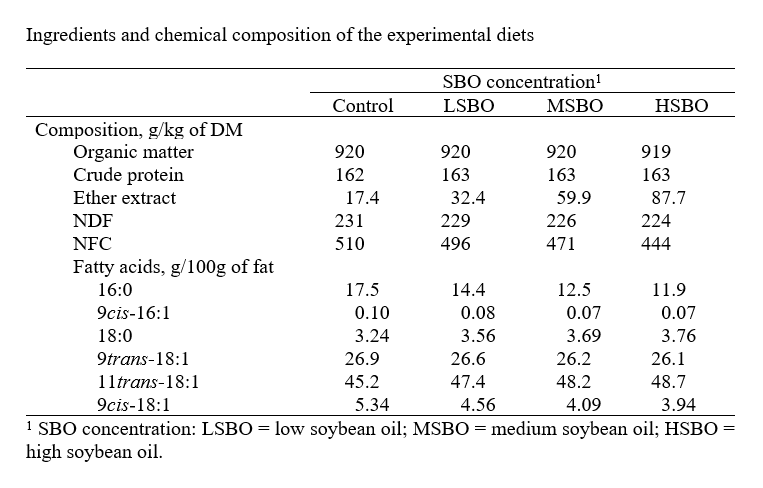
Perfil de ácidos graxos do leite em vacas no pós-parto alimentadas com cana-de-açúcar e diferentes níveis de óleo de soja
2 - Universidade Federal de Viçosa
3 - Universidade Federal de Viçosa
4 - Universidade Federal de Uberlândia
5 - Universidade Federal de Viçosa
6 - Universidade Federal de Viçosa
7 - Universidade Federal de Viçosa
8 - Universidade Federal de Viçosa
RESUMO -
Objetivou-se avaliar os efeitos de níveis crescentes de óleo de soja (OS) em dietas à base de cana de açúcar sobre o perfil de ácidos graxos no leite, com foco no ácido linoleico conjugado (CLA). Quatorze vacas primíparas (545 ± 17,2 kg PC) e oito multíparas (629 ± 26,7 kg PC) da raça Holandês no pós-parto foram utilizadas. As dietas foram formuladas com concentrações crescentes de OS (g/kg de matéria seca (MS)): controle (0), baixo (BOS, 15,7), médio (MOS, 44,3) e alto (AOS, 73,4). O OS aumentou quadraticamente a produção do 9cis,11trans-18:2CLA e aumentou linearmente a concentração deste no leite. A presença de 10trans,12cis-18:2CLA no leite só foi observada nas dietas MOS e AOS. A dieta BOS promoveu a produção de CLA sem maior depressão da gordura do leite. A fim de aumentar a concentração de 9cis,11trans-18:2CLA na gordura do leite sem diminuição na ingestão e na produção de leite e gordura, recomenda-se a suplementação de 15,7 g de OS / kg de MS em dietas com cana de açúcar.
Milk fatty acids profile in fresh cows fed sugarcane and levels of soybean oil
ABSTRACT - The effects of increasing levels of soybean oil (SBO) in sugarcane-based diets on milk fatty acids profile, focusing on conjugated linoleic acid (CLA), were evaluated. Fourteen primiparous (545 ± 17.2 kg BW) and eight multiparous (629 ± 26.7 kg BW) Holstein fresh cows were randomly assigned within the two parity groups. The diets were formulated with increasing concentrations of SBO (g/kg of dry matter (DM)): control (0), low (LSBO; 15.7), medium (MSBO; 44.3) and high (HSBO; 73.4). The SBO inclusion increased quadratically the 9cis,11trans-18:2CLA yield and increased linearly the concentration of 9cis,11trans-18:2CLA in milk. The presence of 10trans,12cis-18:2CLA in milk was observed only in MSBO and HSBO diets. The LSBO diet promoted the CLA production without greater milk fat depression. In order to increase the yield of 9cis,11trans-18:2CLA without great decreasein intake and milk and fat production, SBO supplementation at15.7 g SBO/kg DM is recommended.Introdução
The use of sugarcane in ruminant feed has been extensively common in Brazil, especially in the period of feed shortage for the herd. However, this forage has high concentrations of indigestible fiber, thus limiting intake and, therefore, limiting milk production. In the postpartum period, when cows are in a negative energy balance and feed intake is still low, it is necessary to increase the energy intake by increasing the energy density of the diets. Thus, an alternative would be the lipid supplementation with vegetable oils, such as soybean oil (SBO). In addition the SBO supplementation can increase the milk conjugated linoleic acid (CLA) concentrations, which can improve the consumer’s health. Therefore, studies have been developed to increase the concentration of these fatty acids (FA) in milk fat, as the population is increasingly concerned with food health. Based on the hypothesis that SBO supplementation increases milk CLA, this study was conducted aiming to investigatethe inclusion of SBO at levels higher than conventional in milk FA profile of cows after calving fed sugarcane-based diets. Given the lack of milk FA studies with sugarcane our objective was find optimum levels of SBO inclusion to increase milk CLA in cows fed this forageRevisão Bibliográfica
Due to the potential nutraceutical properties of milk fatty acids (FA), studies evaluating changes in milk FA profile encompassing alterations in dairy cows’ diets have been made in recent years (Shingfield & Wallace, 2014). The CLA isomers have shown positive effects on human health, reducing the risk of diseases such as cancer, obesity and immune disorders (Kanwar et al., 2016). Dairy products are an important source of CLA in human nutrition and a better understanding of rumen biohydrogenation of polyunsaturated FA (PUFA) is key in order to increase CLA concentration in milk. The use of plant oils such as SBO to feed cows generally is constrained to levels up to 60 or 70 g of EE per kg of DM to avoid deleterious effects on fibre digestibility (Lewis et al., 1999; NRC, 2001). In this way, studies evaluating the effects of vegetable oils, in general, do not use to reach levels of fat higher than recommended (Glasser et al.). Besides the small volume of data evaluating high levels of vegetable oils, it is well known that the forage type and level in the diet affects the response to fat supplementation inruminal lipid metabolism and milk FA composition (Vazirigohar et al., 2014). Diets with sugarcane have limitations in energy intake as consequence of the high indigestible fraction in neutral detergent fibre (NDF) (Oliveira et al., 2011). Thus supplementation with vegetable oils can be an alternative to increase the energy intake and decrease the negative energy balance effects of post-partum dairy cows fed sugar cane. According to Dias et al. (2010), postpartum lipid supplementation may be a possible strategy for improvement of reproductive performance in bovine females. However, there is a lack of research about strategies to alter rumen lipid metabolism and milk FA using SBO with different sources of forage and feeding systems (Rennó et al., 2013). Indeed, data about ruminal lipid metabolism and milk FA from cows fed tropical forages such as sugarcane and fat levels in the diet are limited in the literature.Materiais e Métodos
Fourteen primiparous (545 ± 17.2 kg BW) and eight multiparous (629 ± 26.7 kg BW) Holstein cows after calving were used. Cows were randomly assigned within the two parity groups to the diets. The experiment was designed to be analysed using 24 animals; however, two primiparous cows sorted to the control and MSBO diets were removed from the study due to babesiosis and dystocia followed by caesarean, respectively. Diets were formulated with increasing concentrations of SBO (g/kg of dry matter (DM)): control (0), low (LSBO; 15.7), medium (MSBO; 44.3) and high (HSBO; 73.4)(Table 1). The cows were milked twice a day and diets were offered on an ad libitum basis (target 100 g refusal/kg fed) and the amount offered was adjusted daily. The study was performed from calving until 84 days in milk (DIM), divided in three periods of 28 d each. Samples of sugarcane and orts were taken from day 13 to 16 of each period and pooled for chemical analysis. Milk samples were taken on day 14 and 15 of each period during each milk session. Samples of feed and orts were oven-dried at 55°C for 72 h and grounded through 2- and 1-mm screens (Wiley mill; A. H. Thomas, Philadelphia, PA) for further analyses. The DM, organic matter (OM), CP, and ether extract (EE) content of feeds, orts, and milk were determined according to the AOAC (2005). The concentration of NDF was determined using heat stable α-amylase with a fibre analyser ANKOM 220, using the AOAC (2005). Frozen aliquots of feeds were lyophilized and milled through a 1 mm screen. The FA profile of the feeds was determined by the extraction method described by Folch et al. (1957) and the desaturase index (DI) was calculated for pairs of FA as: product of Δ9-desaturase/ (product of Δ9-desaturase + substrate of Δ9-desaturase) (Kelsey et al., 2003).Resultados e Discussão
Soybean oil decreased (P<0.05) milk fat concentration, however, due to the greater increase in milk yield, fat yield was not affected (P>0.05). The SBO raised quadratically the 9cis,11trans-18:2CLA yield (P<0.05). The concentration of 9cis,11trans-18:2CLA in milk increased linearly (P<0.05). Rennó et al. (2013) also observed that SBO increased 9cis,11trans-18:2CLA in milk of cows after calving. The presence of 10trans,12cis-18:2CLA in milk was observed only in MSBO and HSBO diets. The concentration of both 9cis,11trans-18:2 and 10trans,12cis-18:2CLA in milk fat were affected (P<0.05) by period. The effect of period on 9cis,11trans-18:2CLA concentration in milk probably is a consequence of two effects: the increase in mammary gland ∆9-desaturase activity increase as a function of DIM (Kelsey et al., 2003) and the increase in fat intake (Kay et al., 2005). Keating et al. (2006) observed that 10trans,12cis-18:2CLA decrease the ∆9-desaturase enzyme activity in the mammary gland, decreasing the desaturation of 11trans-18:1 to 9cis,11trans-18:2. In our study the LSBO diet promoted the CLA production without greater milk fat depression (MFD) and decrease in DI of 9cis,11trans-18:2CLA. Fatty acids derived from de novo synthesis (up to 14 carbons) were linearly decreased (P<0.05). Bauman & Griinari (2003) demonstrated the direct effect of 10trans,12cis-18:2CLA increase in milk and the occurrence of MFD and decrease in the de novo synthesis of FA in the mammary gland in cows fed low fibre diets. The concentration of FA greater than 18 carbons boosted quadratically (P<0.05) with the SBO inclusion. MUFA concentration in milk fat raised linearly (P<0.05) until HL level, as well as, PUFA concentration in milk fat increased linearly (P<0.05). The SBO decline quadratically (P<0.05) the OM, with greatest decrease from MSBO to HSBO diet. In addition, the BHR of PUFA quadraticaly increased (P<0.05) with lower increases between the MSBO and HSBO diet. Rodrigues et al (2017) observed that decreased in the intake and increased in BHR of PUFA may be related to the reduction in the fractional rate of passage of iNDF. 9cis,11trans-18:2CLA concentration in milk fat and daily yield of that isomer together may indicate that the upturn in milk CLA concentration is more associated with MFD than the increase in its synthesis in the mammary gland. Based on the low increase in CLA in milk fat at levels greater than MSBO and the absence of an augmentation in CLA produced (g/d), the use of HSBO diet should be not recommended. Furthermore, the decrease in OM intake and milk yield indicate potential adverse effects of feeding cows at the HSBO diet. Despite the linear rise in the concentration of 9cis,11trans-18:2 CLA in milk, the presence of 10trans,12cis-18:2CLA in milk fat at MSBO and HSBO represents another reason to avoid high SBO supplementation. The amount of 9cis,11trans-18:2CLA produced did not show additive response at levels greater than MSBO in this study.Conclusões
In conclusion the additionof SBO proved to be a feasible alternative to rise the 9cis,11trans-18:2CLA contents in milk, however the SBO supplementation to levels between 4,43 and 7,34g SBO/kg DM provided low efficiency of use of substrates to produce 9cis,11trans-18:2CLA in the mammary gland. In order to increase the yield of 9cis,11trans-18:2CLA without great decreasein intake and milk and fat production of dairy cows fed sugarcane-based diets, SBO supplementation at1,57 g SBO/kg DM is recommended.Gráficos e Tabelas




